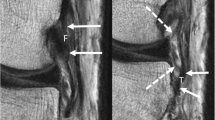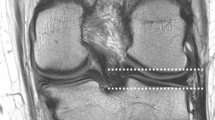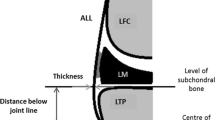Abstract
Objective
The magnetic resonance imaging (MRI) appearance of the anterolateral ligament (ALL) has been described. However, the appearance of this structure and injury, in the presence of anterior cruciate ligament (ACL) injury, is less well defined. We studied the incidence of injury to the ALL and the pattern of this injury on MRI.
Materials and methods
Following Institutional Review Board approval, a retrospective study of 375 consecutive MRI studies was performed. Cases were identified from a prospective database of ACL reconstruction patients. Following exclusions, 280 MRIs (277 patients; 197 males: 80 females; mean age 30.2 years, range, 16–54) were evaluated. Injury was defined as full thickness, partial thickness, or an avulsion fracture. Each study was independently assessed by two consultant musculoskeletal radiologists.
Results
Injury to the ALL was identified (by at least one observer) in only 10.7% of cases (2.50% full thickness, 7.50% partial thickness, and 0.71% avulsion fracture). There was an almost perfect level of interobserver agreement for both the identification of an injury (κ = 0.854) and grading of injury (κ = 0.858). The MRI incidence of ALL injury was significantly greater within 6 weeks of the knee injury (18.5 vs. 8.37%; p < 0.05).
Conclusions
ALL injury was identified in only one-tenth of cases of ACL rupture. MRI changes can be reliably identified with strong agreement between observers. ALL injury is found more frequently on MRI within 6 weeks of the knee injury (compared to scans performed after this time period) suggesting that some injuries may resolve or become less visible.




Similar content being viewed by others
References
Vincent JP, Magnussen RA, Gezmez F, et al. The anterolateral ligament of the human knee: an anatomic and histologic study. Knee Surg Sports Traumatol Arthrosc. 2012;20:147–52.
Claes S, Vereecke E, Maes M, et al. Anatomy of the anterolateral ligament of the knee. J Anat. 2013;223:321–8.
Helito CP, Demange MK, Bonadio MB, et al. Anatomy and histology of the knee anterolateral ligament. Orthop J Sports Med. 2013;1:1–5.
Caterine S, Litchfield R, Johnson M, et al. A cadaveric study of the anterolateral ligament: re-introducing the lateral capsular ligament. Knee Surg Sports Traumatol Arthrosc. 2015;23:3186–95.
Stijak L, Bumbasirevic M, Radonjic V, et al. Anatomical description of the anterolateral ligament of the knee. Knee Surg Sports Traumatol Arthrosc. 2016;24:2083–8.
Monaco E, Ferretti A, Labianca L, et al. Navigated knee kinematics after cutting of the ACL and its secondary restraint. Knee Surg Sports Traumatol Arthrosc. 2012;20:870–7.
Guenther D, Rahnemai-Azar AA, Bell KM, et al. The anterolateral capsule of the knee behaves as a sheet of fibrous tissue. Am J Sports Med. 2016.
Kernkamp WA, Li G, Van de Velde SK. The anterolateral ligament: a closed chapter? Ann Transl Med. 2016;4(Suppl 1):S37.
Tanaka M, Vyas D, Moloney G, et al. What does it take to have high-grade pivot shift? Knee Surg Sports Traumatol Arthrosc. 2012;20:737–42.
Monaco E, Maestri B, Conteduca F, Mazza D, Iorio C, Ferretti A. Extra-articular ACL reconstruction and pivot shift—in vivo dynamic evaluation with navigation. Am J Sports Med. 2014;42:1669–74.
Wroble RR, Grood ES, Cummings JS, Henderson JM, Noyes FR. The role of the lateral extraarticular restraints in the anterior cruciate ligament-deficient knee. Am J Sports Med. 1993;21:257–62.
Musahl V, Rahnemai-Azar AA, Costello J, et al. The influence of meniscal and anterolateral capsular injury on knee laxity in patients with anterior cruciate ligament injuries. Am J Sports Med. 2016;44:3126–31.
Van Dyck P, De Smet E, Lambrecht V, et al. The anterolateral ligament of the knee: what the radiologist needs to know. Semin Musculoskelet Radiol. 2016;20:26–32.
Helito CP, Helito PV, Costa HP, et al. MRI evaluation of the anterolateral ligament of the knee: assessment in routine 1.5-T scans. Skelet Radiol. 2014;43:1421–7.
Kosy JD, Mandalia VI, Anaspure R. Characterisation of the anterolateral ligament of the knee using magnetic resonance imaging. Skelet Radiol. 2015;44:1647–53.
Claes S, Bartholomeeusen S, Bellemans J. High prevalence of anterolateral ligament abnormalities in magnetic resonance images of anterior cruciate ligament-injured knees. Acta Orthop Belg. 2014;80:45–9.
Wodicka R, Jose J, Baraga MG, et al. MRI evaluation of the anterolateral ligament of the knee in the setting of ACL rupture. Orthop J Sports Med. 2014;2(Suppl 2):1.
Helito CP, Helito PV, Costa HP, et al. Assessment of the anterolateral ligament of the knee by magnetic resonance imaging in acute injuries of the anterior cruciate ligament. Arthroscopy. 2016;33:140–6.
Hartigan DE, Carroll KW, Kosarek FJ, et al. Visibility of anterolateral ligament tears in anterior cruciate ligament-deficient knees with standard 1.5 Tesla magnetic resonance imaging. Arthroscopy. 2016;32:2061–5.
Landis JR, Koch GG. The measurement of observer agreement for categorical data. Biometrics. 1977;33:159–74.
Van Dyck P, Clockaerts S, Vanhoenacker FM, et al. Anterolateral ligament abnormalities in patients with acute anterior cruciate ligament rupture are associated with lateral meniscal and osseous injuries. Eur Radiol. 2016;26:3383–91.
Taneja AK, Miranda FC, Braga CA, et al. MRI features of the anterolateral ligament of the knee. Skelet Radiol. 2015;44:403–10.
Porrino Jr J, Maloney E, Richardson M, et al. The anterolateral ligament of the knee: MRI appearance, association with the Segond fracture, and historical perspective. AJR Am J Roentgenol. 2015;204:367–73.
Author information
Authors and Affiliations
Corresponding author
Ethics declarations
Conflict of interest
The authors declare that they have no conflicts of interest.
Ethical approval
All procedures performed in studies involving human participants were in accordance with the ethical standards of the institutional and/or national research committee and with the 1964 Helsinki Declaration and its later amendments or comparable ethical standards.
Informed consent
This article does not contain patient data.
Rights and permissions
About this article
Cite this article
Kosy, J.D., Schranz, P.J., Patel, A. et al. The magnetic resonance imaging appearance of the anterolateral ligament of the knee in association with anterior cruciate rupture. Skeletal Radiol 46, 1193–1200 (2017). https://doi.org/10.1007/s00256-017-2657-y
Received:
Revised:
Accepted:
Published:
Issue Date:
DOI: https://doi.org/10.1007/s00256-017-2657-y




